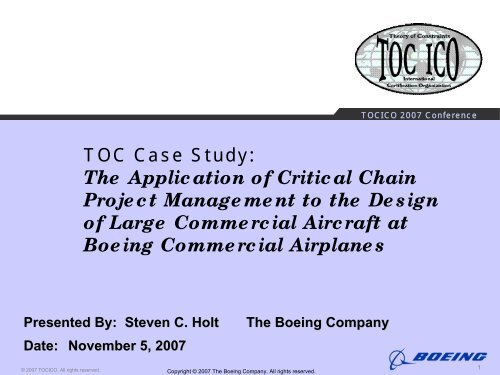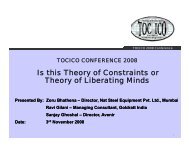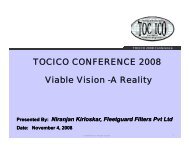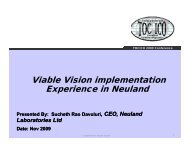TOC Case Study - Private Network Solutions
TOC Case Study - Private Network Solutions
TOC Case Study - Private Network Solutions
You also want an ePaper? Increase the reach of your titles
YUMPU automatically turns print PDFs into web optimized ePapers that Google loves.
© 2007 <strong>TOC</strong>ICO. All rights reserved.<br />
<strong>TOC</strong>ICO 2007 Conference<br />
<strong>TOC</strong> <strong>Case</strong> <strong>Study</strong>:<br />
The Application of Critical Chain<br />
Project Management to the Design<br />
of Large Commercial Aircraft at<br />
Boeing Commercial Airplanes<br />
Presented By: Steven C. Holt The Boeing Company<br />
Date: November 5, 2007<br />
Copyright © 2007 The Boeing Company. All rights reserved.<br />
1
Opportunity or Something Else?<br />
© 2007 <strong>TOC</strong>ICO. All rights reserved.<br />
Copyright © 2007 The Boeing Company. All rights reserved.<br />
2<br />
<strong>TOC</strong>ICO 2007 Conference<br />
Suppose you’re asked to implement Critical Chain on<br />
a project in which:<br />
• The project due date is set and is unchangeable.<br />
• Finishing early/under budget won’t impact the final<br />
product<br />
• The implementation is only in one functional area in<br />
one part of the overall project.<br />
• Only half the resources are on site, 25% are<br />
overseas<br />
• The organization has a strong intermediary due date<br />
culture.<br />
• And you’ve never done an implementation before<br />
Would you do it? We said, “Yes.”
Development of New Aircraft<br />
•<br />
•<br />
•<br />
•<br />
© 2007 <strong>TOC</strong>ICO. All rights reserved.<br />
Copyright © 2007 The Boeing Company. All rights reserved.<br />
3<br />
<strong>TOC</strong>ICO 2007 Conference<br />
Aircraft models are designed to meet airline needs<br />
in specific market niches.<br />
−<br />
New designs create platforms that allow derivative<br />
models<br />
The demand for aircraft is tied to global economic<br />
cycles.<br />
Success is creating the right aircraft at the right<br />
time at a price the market can afford.<br />
There are often multiple, competing design efforts<br />
across the global system, so doing more with less<br />
in less time is mandatory. This is particularly true<br />
for Airframe engineers.
777-200LR/-300ER Derivatives<br />
Over 50% of the airplane had to be changed from current design.<br />
The majority of the development work was done by Airframe.<br />
Tail strike<br />
protection<br />
Increased fuel<br />
capacity<br />
Provisions for three<br />
optional fuel tanks in aft<br />
cargo compartment<br />
(-200LR)<br />
© 2007 <strong>TOC</strong>ICO. All rights reserved.<br />
Overhead Crew<br />
Rest Provision<br />
Strengthened<br />
body, wing, and<br />
empennage<br />
New main landing gear and<br />
strengthened nose gear<br />
New wheels, tires, and brakes<br />
Copyright © 2007 The Boeing Company. All rights reserved.<br />
4<br />
6.5-ft wingtip<br />
extension<br />
Increased thrust<br />
engines<br />
<strong>TOC</strong>ICO 2007 Conference<br />
Revised struts<br />
and nacelles<br />
Semi-levered gear<br />
(-300ER)
Development Timeline<br />
© 2007 <strong>TOC</strong>ICO. All rights reserved.<br />
777-200LR<br />
Copyright © 2007 The Boeing Company. All rights reserved.<br />
5<br />
<strong>TOC</strong>ICO 2007 Conference<br />
777-300ER
The Business Environment<br />
© 2007 <strong>TOC</strong>ICO. All rights reserved.<br />
Copyright © 2007 The Boeing Company. All rights reserved.<br />
6<br />
<strong>TOC</strong>ICO 2007 Conference<br />
“Challenging” business goals set for both schedule<br />
and budget. Entry Into Service dates set at Program<br />
Launch.<br />
Airframe resources provided additional challenges:<br />
−<br />
−<br />
35% Boeing, 65% contract & Industry Assist<br />
50% collocated, 25% in US, 25% outside US<br />
Suite of Best Practices required by program<br />
−<br />
Earned Value<br />
− Lean
Implementation Intended Result<br />
© 2007 <strong>TOC</strong>ICO. All rights reserved.<br />
Copyright © 2007 The Boeing Company. All rights reserved.<br />
7<br />
<strong>TOC</strong>ICO 2007 Conference<br />
Reduce the time and resources needed to complete<br />
detail design. This will free up resources for other<br />
programs and give the supply chain enough time to<br />
make the parts.<br />
“Development resources are proportional to<br />
development time.” Clark-Fujimoto Rule<br />
“All we are doing is looking at the time line from the<br />
moment the customer gives us an order to the point<br />
when we collect the cash. And we are reducing that<br />
time line by removing the non-value-added wastes.”<br />
Taiichi Ohno (1988)
“A Few Implementation Issues”<br />
•<br />
•<br />
•<br />
•<br />
•<br />
•<br />
•<br />
•<br />
•<br />
What is a project? Task? Activity?<br />
What are the boundaries?<br />
CCPM? Why not DBR?<br />
What is included? What’s not?<br />
What software do we use?<br />
Do we need outside help?<br />
Can we overcome a strong “due date” bias?<br />
© 2007 <strong>TOC</strong>ICO. All rights reserved.<br />
Copyright © 2007 The Boeing Company. All rights reserved.<br />
8<br />
<strong>TOC</strong>ICO 2007 Conference<br />
How do we integrate CCPM with Earned Value?<br />
How do we integrate CCPM with Lean?<br />
We needed an<br />
implementation plan to<br />
focus our efforts
Airframe Span of Control<br />
Product Development<br />
A “V” Plant<br />
Program<br />
Launch<br />
Firm<br />
Concept<br />
Firm<br />
Configuration<br />
© 2007 <strong>TOC</strong>ICO. All rights reserved.<br />
Detail<br />
Design<br />
Release Drawings<br />
Copyright © 2007 The Boeing Company. All rights reserved.<br />
9<br />
Parts<br />
Fabrication<br />
Assembly<br />
<strong>TOC</strong>ICO 2007 Conference<br />
Production<br />
An “A” Plant<br />
Entry Into<br />
Service<br />
Test Delivery<br />
System boundaries and goals drive the design of the implementation<br />
and vice versa.
Implementation Strategy Table<br />
Options<br />
Decision Categories<br />
Scope of<br />
Organization<br />
Level 4 - Lead<br />
Level<br />
Level 3 - First<br />
level<br />
management<br />
Level 2-Airplane<br />
Section<br />
Level 1 - All of<br />
Airframe<br />
Level 0 - All of<br />
777<br />
© 2007 <strong>TOC</strong>ICO. All rights reserved.<br />
Scope of<br />
Work<br />
Statement<br />
200LR,<br />
300ER<br />
releases<br />
Add<br />
Customer<br />
Intros<br />
Add<br />
Committed<br />
Changes<br />
Add Noncommitted<br />
Changes<br />
Scope of<br />
Process<br />
In-House<br />
Only<br />
Add any<br />
Define Off-<br />
Loads<br />
Add<br />
Suppliers<br />
Add<br />
Regulatory<br />
Agencies<br />
Add<br />
Customers<br />
and<br />
Marketing<br />
Project<br />
Product<br />
Drawings<br />
Add<br />
Reference<br />
Notes<br />
Add<br />
Manufacturing<br />
Plans<br />
Add Tool<br />
Design<br />
Add Tool<br />
Construction*<br />
add Parts<br />
Add<br />
Components<br />
deliver to Fab<br />
Project<br />
Environment<br />
10<br />
Limited Pilot<br />
Project<br />
Multiple Stand<br />
Alone Projects<br />
Apply at Critical<br />
Bottleneck<br />
(program<br />
constraint)<br />
Multi-Project,<br />
Shared Resouce<br />
Copyright © 2007 The Boeing Company. All rights reserved.<br />
Integration w/<br />
Best<br />
Practices<br />
Independent<br />
<strong>TOC</strong>ICO 2007 Conference<br />
Infrastructure<br />
In house, local<br />
practioners<br />
Buffers<br />
Used<br />
Schedule<br />
Dependent Consultants plus Cost<br />
Interdependent plusTrainers<br />
plus Application<br />
Practicioners<br />
plus Outside<br />
experts<br />
plus<br />
Performance<br />
Targets
Getting Started<br />
•<br />
•<br />
•<br />
© 2007 <strong>TOC</strong>ICO. All rights reserved.<br />
11<br />
Copyright © 2007 The Boeing Company. All rights reserved.<br />
<strong>TOC</strong>ICO 2007 Conference<br />
Strategy table helped define the system, the<br />
boundaries and our direction<br />
John Kotter’s “Leading Change” provided a<br />
basis for implementing change<br />
Formed implementation team and Guiding<br />
Coalition<br />
− Understand current state, design future state<br />
− Develop the infrastructure (tools, reports, trng)<br />
− Define the tactical implementation plan<br />
− Implement the plan
Implementation Decisions<br />
•<br />
•<br />
•<br />
Treat each drawing as a separate project.<br />
−<br />
−<br />
© 2007 <strong>TOC</strong>ICO. All rights reserved.<br />
12<br />
Copyright © 2007 The Boeing Company. All rights reserved.<br />
<strong>TOC</strong>ICO 2007 Conference<br />
Drawings are contractual deliverables to suppliers with<br />
negotiated due dates.<br />
Required to track Earned Value at the drawing level.<br />
A multi-project system of 10000 projects.<br />
−<br />
−<br />
−<br />
About 30 unique Sub-Teams/resource pools<br />
Each team had 75 to 3000 projects<br />
Each team had a Critical Chain scheduler/plan<br />
Objective: Prioritized project/drawing release<br />
“waterfall” set by a drum for each team that meets<br />
supplier’s needs
Initial System Design Enabled Software<br />
Decision<br />
•<br />
© 2007 <strong>TOC</strong>ICO. All rights reserved.<br />
13<br />
Copyright © 2007 The Boeing Company. All rights reserved.<br />
<strong>TOC</strong>ICO 2007 Conference<br />
Multiple teams and resource pools meant that a<br />
complete enterprise CCPM software solution was<br />
not (yet) needed.<br />
− Used Sciforma PS8—good value, excellent<br />
ability to customize and integrate into other<br />
systems.<br />
− We could operate to CCPM run rules and report<br />
conventional metrics to business systems with<br />
minimal effort. Especially Earned Value.
Planning and Execution of the Work<br />
•<br />
•<br />
•<br />
© 2007 <strong>TOC</strong>ICO. All rights reserved.<br />
14<br />
Copyright © 2007 The Boeing Company. All rights reserved.<br />
<strong>TOC</strong>ICO 2007 Conference<br />
Create the Plan<br />
− Apply templates to work statement, no dates<br />
Commit the Plan<br />
− Assign completion dates to projects, adjust<br />
resources<br />
Manage to the Plan<br />
− Use resource histograms and fever charts for<br />
daily management<br />
− Drawing due date system to check weekly<br />
commitments<br />
− Earned Value to show monthly progress
First Steps: Prioritize and Train<br />
Eliminate harmful multi-tasking, provide<br />
focus, increase speed.<br />
•<br />
•<br />
Created a Task Prioritization policy<br />
Team training and education<br />
What we learned:<br />
•<br />
•<br />
Having a policy isn’t enough, it requires<br />
constant reinforcement.<br />
© 2007 <strong>TOC</strong>ICO. All rights reserved.<br />
15<br />
Copyright © 2007 The Boeing Company. All rights reserved.<br />
<strong>TOC</strong>ICO 2007 Conference<br />
Apply the training immediately or people<br />
revert to what they know
Education and Training<br />
© 2007 <strong>TOC</strong>ICO. All rights reserved.<br />
16<br />
Copyright © 2007 The Boeing Company. All rights reserved.<br />
<strong>TOC</strong>ICO 2007 Conference<br />
Everyone needed enough knowledge for their role:<br />
•<br />
•<br />
•<br />
Internally we drew upon employees with <strong>TOC</strong><br />
education from the Washington State University’s<br />
Engineering & Technology Management program<br />
for implementation help.<br />
Licensed the capability to present 2 Day <strong>TOC</strong> Multi-<br />
Project Management workshop developed by Tony<br />
Rizzo of Product Development Institute<br />
Created a 2 hour overview based in part on<br />
simulations from “Project Management the <strong>TOC</strong><br />
Way.”
Planning & Working Behaviors<br />
Team members share<br />
responsibility for project<br />
deliverables<br />
Plan using 50%<br />
probabilities for task<br />
durations, not 80%<br />
© 2007 <strong>TOC</strong>ICO. All rights reserved.<br />
All team members work to the same priorities<br />
Start only when ALL the prerequisites are complete<br />
17<br />
Copyright © 2007 The Boeing Company. All rights reserved.<br />
<strong>TOC</strong>ICO 2007 Conference<br />
Status by estimating<br />
duration remaining, not<br />
% complete<br />
NO multi-tasking<br />
Finish when you’re<br />
done, not when it’s<br />
due
Next: Create Team Plans<br />
© 2007 <strong>TOC</strong>ICO. All rights reserved.<br />
18<br />
Copyright © 2007 The Boeing Company. All rights reserved.<br />
<strong>TOC</strong>ICO 2007 Conference<br />
Create resource-based project plans<br />
− Create planning models using common<br />
templates (engineers understand the use<br />
of models to simulate reality)<br />
− Critical Chain Project Management plan<br />
for every Sub team<br />
− All of the committed work done by the<br />
team resources is in the team plan<br />
− The plan is resource feasible and<br />
projects are in the right sequence
A Sample Project Template<br />
Drawing_Template<br />
Task Name Resource Names Duration<br />
© 2007 <strong>TOC</strong>ICO. All rights reserved.<br />
19<br />
Safe<br />
Duration<br />
Summary 18.49d 0d<br />
ME Task 1 ME 0.24d 1d<br />
DWG Creation Design 4d 10d<br />
Checknotes & ANI Stress 0.5d 2d<br />
Feeding Buffer 0d 0d<br />
Design Check Design 1d 3d<br />
Pickups Design 1d 2d<br />
Team Check Stress,ME,Tooling,Design 3d 5d<br />
Incorporate Pickups Design 1d 2d<br />
Sig Routing Design,Stress,ME,Tooling 1d 1d<br />
Release Engineering OB 0d 0d<br />
EDC flow 7d 7d<br />
ME Task 2 ME 0.25d 1d<br />
Project Buffer 5d 0d<br />
Copyright © 2007 The Boeing Company. All rights reserved.<br />
<strong>TOC</strong>ICO 2007 Conference
Sample Synchronized Team Plan<br />
© 2007 <strong>TOC</strong>ICO. All rights reserved.<br />
Sample Level 4 Team Planning Model (Synchronized)<br />
20<br />
Copyright © 2007 The Boeing Company. All rights reserved.<br />
<strong>TOC</strong>ICO 2007 Conference<br />
Project ID Task Name Duration Task ID DurationSafe Duration Oct<br />
Qtr4, 2000<br />
Nov Dec Jan<br />
Qtr1, 2001<br />
Feb Mar Apr<br />
Qtr2, 2001<br />
May Jun Jul<br />
Qtr3, 2001<br />
Aug<br />
9 16 23 30 6 13 20 27 4 11 18 25 1 8 15 22 29 5 12 19 26 5 12 19 26 2 9 16 23 30 7 14 21 28 4 11 18 25 2 9 16 23 30 6 13 20 27<br />
003-9P_525 37d 525 37d 0d<br />
004-9P_527 37d 527 37d 0d<br />
001-9P_322 37d KC8 37d 0d<br />
002-9P_521 37d 521 37d 0d<br />
007-9P_513 39d 513 39d 0d<br />
005-9P_324 39d 324 39d 0d<br />
006-9P_511 39d 511 39d 0d<br />
008-9P_523 39d 523 39d 0d<br />
022-9P_853 13d 1 13d 0d<br />
023-9P_855 13d 1 13d 0d<br />
019-9P_440 13d 440 13d 0d<br />
021-9P_851 13d 1 13d 0d<br />
010-9P_541 43d 541 43d 0d<br />
009-9P_545 43d 545 43d 0d<br />
011-9P_543 43d 543 43d 0d<br />
012-9P_547 43d KC8 43d 0d<br />
026-9P_800 13d 1 13d 0d<br />
027-9P_801 13d 1 13d 0d<br />
029-9P_803 13d 1 13d 0d<br />
028-9P_802 13d 1 13d 0d<br />
014-9P_412 37d 411 37d 0d<br />
015-9P_421 37d 412 37d 0d<br />
013-9P_411 37d 547 37d 0d<br />
016-9P_422 37d 421 37d 0d<br />
020-9P_441 37d 1KC8 37d 0d<br />
018-9P_432 37d 431 37d 0d<br />
017-9P_431 37d 422 37d 0d<br />
024-9P_652 37d KC8 37d 0d<br />
025-9P_313 37d KC8 37d 0d<br />
030-9P_532 37d KC8 37d 0d
Lessons from Team Plans<br />
© 2007 <strong>TOC</strong>ICO. All rights reserved.<br />
21<br />
Copyright © 2007 The Boeing Company. All rights reserved.<br />
<strong>TOC</strong>ICO 2007 Conference<br />
They didn’t want to start; then didn’t want to stop.<br />
•<br />
•<br />
•<br />
•<br />
“Low hanging” process improvements show up as<br />
a result of talking to each other.<br />
Teams without Planning Sessions often commit to<br />
unrealistic and infeasible schedules<br />
Having a “planning model” allows new insights and<br />
“what if” scenario planning that previously was<br />
very difficult and often skipped<br />
Groups that usually don’t get involved with<br />
planning (like the Critically Constrained Resource)<br />
often really want to.
Manage to the Plan<br />
© 2007 <strong>TOC</strong>ICO. All rights reserved.<br />
22<br />
Copyright © 2007 The Boeing Company. All rights reserved.<br />
<strong>TOC</strong>ICO 2007 Conference<br />
Use our plans to manage using Buffer<br />
Management and follow our prioritization and<br />
No Multi-tasking policies<br />
Put in place tools and processes to:<br />
− Make informed resource management decisions<br />
− Revise task priorities<br />
− Predict future performance<br />
− Seek help in a timely manner<br />
− Provide help in a timely manner<br />
− Coordinate downstream impacts<br />
− Validate the team’s capacity
Manage to the Plan (2)<br />
Use Buffer Management to manage.<br />
© 2007 <strong>TOC</strong>ICO. All rights reserved.<br />
23<br />
Copyright © 2007 The Boeing Company. All rights reserved.<br />
<strong>TOC</strong>ICO 2007 Conference<br />
− Assign tasks at 2 week look ahead window, do<br />
not assign all work to individuals up front<br />
Lessons: Years of habits are hard to break.<br />
− Start Buffer Management team by team as<br />
soon as plans are completed to minimize fall<br />
back to “business as usual” behavior.<br />
− People want to assign all work to individuals.<br />
Don’t let them….
Due Date Vicious Cycle<br />
•<br />
•<br />
Common perception:<br />
© 2007 <strong>TOC</strong>ICO. All rights reserved.<br />
24<br />
Copyright © 2007 The Boeing Company. All rights reserved.<br />
<strong>TOC</strong>ICO 2007 Conference<br />
“I must start now or I’ll miss my due date. I don’t<br />
have all the information I need, so I’ll make<br />
estimates and assumptions and use those.”<br />
The group most fixated on due dates was<br />
responsible for the efforts upstream and<br />
downstream of the drum resource.<br />
− This buried the drum with WIP in varying<br />
degrees of completeness and correctness.<br />
Policy: Only pass correct, completed work to<br />
the drum.
Results of Due Date Focus<br />
% Buffer Incursion<br />
150<br />
140<br />
130<br />
120<br />
110<br />
100<br />
90<br />
80<br />
70<br />
60<br />
50<br />
40<br />
30<br />
20<br />
10<br />
0<br />
© 2007 <strong>TOC</strong>ICO. All rights reserved.<br />
146<br />
73<br />
124<br />
40<br />
149<br />
83<br />
81<br />
135<br />
106<br />
25<br />
100<br />
135<br />
81<br />
73<br />
75<br />
72 73<br />
109<br />
107<br />
80<br />
Copyright © 2007 The Boeing Company. All rights reserved.<br />
99<br />
120<br />
45<br />
89<br />
10<br />
63<br />
102<br />
70<br />
43<br />
0 0<br />
0 0 0 0 0<br />
0<br />
0<br />
150<br />
59<br />
79<br />
<strong>TOC</strong>ICO 2007 Conference<br />
0 10 20 30 40 50 60 70 80 90 100<br />
% Critical Chain Complete<br />
110<br />
150<br />
60<br />
2930<br />
16<br />
137<br />
128<br />
113 113<br />
114
777-300ER Results<br />
•<br />
© 2007 <strong>TOC</strong>ICO. All rights reserved.<br />
26<br />
Copyright © 2007 The Boeing Company. All rights reserved.<br />
<strong>TOC</strong>ICO 2007 Conference<br />
Airframe 777-300ER: First large scale,<br />
Multi-project, Shared resource<br />
implementation in Boeing<br />
−Most drawing release commitments<br />
made prior to creation of CCPM plans<br />
−Critical Chain prioritization on drum<br />
resource brought the program in on<br />
schedule and under original budget<br />
estimates
Earned Value Reports-Before<br />
1.3<br />
1.2<br />
1.1<br />
1.0<br />
0.9<br />
0.8<br />
© 2007 <strong>TOC</strong>ICO. All rights reserved.<br />
Contractor2 1 CPAF RDTE<br />
CPI and SPI<br />
2001<br />
MAR APR MAY JUN JUL AUG SEP OCT NOV DEC<br />
Element: LR777.01 Name: AFIT<br />
Index of Dollars Cost Performance Index (CPI)<br />
Schedule Performance Index (SPI)<br />
27<br />
Copyright © 2007 The Boeing Company. All rights reserved.<br />
<strong>TOC</strong>ICO 2007 Conference<br />
2002<br />
JAN FEB
Earned Value Reports-After<br />
1.3<br />
1.2<br />
1.1<br />
1.0<br />
0.9<br />
0.8<br />
© 2007 <strong>TOC</strong>ICO. All rights reserved.<br />
Contractor2 1 CPAF RDTE<br />
CPI and SPI<br />
2001<br />
MAR APR MAY JUN JUL AUG SEP OCT NOV DEC<br />
Element: LR777.01 Name: AFIT<br />
Index of Dollars<br />
Cost Performance Index (CPI)<br />
Schedule Performance Index (SPI)<br />
28<br />
Copyright © 2007 The Boeing Company. All rights reserved.<br />
<strong>TOC</strong>ICO 2007 Conference<br />
2002<br />
JAN FEB
2 nd 777 Airframe Implementation<br />
777-200LR:<br />
•<br />
•<br />
•<br />
•<br />
© 2007 <strong>TOC</strong>ICO. All rights reserved.<br />
29<br />
Copyright © 2007 The Boeing Company. All rights reserved.<br />
<strong>TOC</strong>ICO 2007 Conference<br />
Drawing release commitments made based<br />
on resource feasible CCPM plans<br />
Project network and templates used to<br />
create entire plan<br />
Had trained staff, documented processes<br />
Resource Histograms showed overload<br />
situation late in 2003, team took action<br />
immediately (Everyone believed the data!).
777-200LR Release Performance<br />
© 2007 <strong>TOC</strong>ICO. All rights reserved.<br />
30<br />
Copyright © 2007 The Boeing Company. All rights reserved.<br />
Engineering<br />
thought that this<br />
was a VERY<br />
aggressive<br />
schedule<br />
<strong>TOC</strong>ICO 2007 Conference
Speed & Quality “Virtuous” Cycle<br />
•<br />
•<br />
•<br />
© 2007 <strong>TOC</strong>ICO. All rights reserved.<br />
31<br />
Copyright © 2007 The Boeing Company. All rights reserved.<br />
<strong>TOC</strong>ICO 2007 Conference<br />
If you’re a month ahead of schedule and you<br />
find a problem, you fix it.<br />
Fewer errors means less rework in the<br />
system means you finish work earlier and<br />
start the next project earlier.<br />
One measure of this is the number of<br />
reschedule requests:<br />
− Requests at 1/12 th and 1/8 th previous two<br />
derivatives
Yes, but why….?<br />
•<br />
•<br />
•<br />
Why CCPM and not DBR?<br />
© 2007 <strong>TOC</strong>ICO. All rights reserved.<br />
32<br />
Copyright © 2007 The Boeing Company. All rights reserved.<br />
<strong>TOC</strong>ICO 2007 Conference<br />
− We were used to project management and being<br />
measured to a project management system.<br />
Why only Airframe?<br />
− With increasing span comes increasing<br />
benefits…and risks.<br />
Why 10000 projects, why not 1?<br />
− We leveraged our natural tendency to think in<br />
terms of due dates. Note that if people release<br />
when the work is done and ignore due dates then<br />
due dates have no impact on behavior.
Yes, but how…?<br />
•<br />
•<br />
How did you integrate CCPM with EV?<br />
We used several methods:<br />
© 2007 <strong>TOC</strong>ICO. All rights reserved.<br />
− Count method<br />
− % Critical Chain = EV % Complete<br />
− Automated 0/100 earning method<br />
(considered tamper proof)<br />
How’d you integrate with Lean?<br />
33<br />
Copyright © 2007 The Boeing Company. All rights reserved.<br />
<strong>TOC</strong>ICO 2007 Conference<br />
− Taiichi Ohno uses the relay-race analogy and it<br />
provides a good way to show how CCPM<br />
promotes a continuous flow of projects
The Implementation Challenges<br />
•<br />
•<br />
© 2007 <strong>TOC</strong>ICO. All rights reserved.<br />
34<br />
Copyright © 2007 The Boeing Company. All rights reserved.<br />
<strong>TOC</strong>ICO 2007 Conference<br />
The biggest challenge to implementing Critical Chain<br />
is getting people to work to an event driven, Pull<br />
paradigm and not a task due date driven Push<br />
paradigm. And, adding more details doesn’t help.<br />
Second biggest challenge: Yes, it really does work.<br />
“Whether you think you can or think you can’t--you’re<br />
right.” Henry Ford<br />
“Whether you think CCPM can work or think it can’t--<br />
you’re right.”
The Implementation Situation<br />
© 2007 <strong>TOC</strong>ICO. All rights reserved.<br />
If this is people’s perception of reality:<br />
A B C D E<br />
And this schedule is “unrealistic”:<br />
A B C D E<br />
Then how do we get<br />
people to commit<br />
to a schedule like this?<br />
A B C D E<br />
35<br />
Buffer<br />
Copyright © 2007 The Boeing Company. All rights reserved.<br />
Need to finish<br />
<strong>TOC</strong>ICO 2007 Conference<br />
Business <strong>Case</strong><br />
Won’t Close<br />
Committed<br />
Date
Where We are Today:<br />
•<br />
•<br />
•<br />
•<br />
•<br />
© 2007 <strong>TOC</strong>ICO. All rights reserved.<br />
36<br />
Copyright © 2007 The Boeing Company. All rights reserved.<br />
<strong>TOC</strong>ICO 2007 Conference<br />
We have a way to implement Large Scale Multi-<br />
Project Critical Chain in Engineering Product<br />
Development.<br />
We have proof of success.<br />
There is easy access to implementation information.<br />
There are a growing number of experienced<br />
practitioners.<br />
There’s significant upside potential for productivity<br />
improvement and associated business performance<br />
increases with the only risk being “business as<br />
usual” performance.










